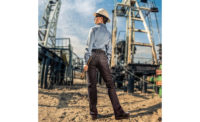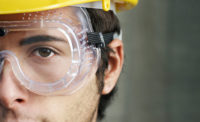Fabric affects the feel
So what really affects the comfort of FR clothing? There are a number of fabric characteristics that play a role in how comfortable the clothing feels.
? Fabric Weight – lighter-weight fabrics generally feel more comfortable on the job and can be cooler in hot weather conditions since they typically don’t have as much insulation as heavier fabrics
- Breathability (air permeability) – breathable fabrics are better at allowing heat and moisture vapor to radiate off the body, which is how the greatest percentage of body heat gets released
- Feel/Softness – fabrics that are softer to the touch feel better next to the skin; a lightweight, breathable fabric that is not soft can make a garment uncomfortable
- Smoothness – fabrics that are smooth and not rough feel better against the skin
- Drape – fabrics that hang naturally and effortlessly under their own weight move with you instead of feeling stiff and binding
- Suppleness – like drape, fabric that is not stiff and can easily compress under pressure generally provides a more comfortable feel
? Moisture Management – a fabric that readily absorbs moisture (sweat) and then dries quickly not only provides cooling in hot humid conditions, but doesn’t leave sweat running down the skin or the “wet rag” feel
Cut influences comfort
In addition to the fabric characteristics, the actual cut of the clothes plays a role in comfort. Having room in areas of movement like shoulders and arms, around the waist, and across the back, as well as pants with a wide waistband and room in the seat, helps to avoid binding.
Options are out there
Wearing uncomfortable FR clothing because you don’t have options for getting the protection you need is a thing of the past. Garments made with comfortable fabrics, and ones cut to allow movement, are readily available today. Even the styling and appearance has improved. Ask the FR garment supplier questions, get the information on comfort characteristics and fit, and try them out before you make a final buying decision. Obviously worker protection is the number-one goal, but if you do your research and arrange for a wear trial before buying, odds are you’ll be able to find a garment that provides the right level of protection, a good fit and a high level of comfort.
Sidebar:
| OSHA offers the following Best Practices for Use of FR Clothing: |
|
• Grease, oil, solvents, or other flammable substances. FR clothing that becomes contaminated with grease, oil, solvents, or other flammable substances should not be used because such contamination greatly reduces the effectiveness of the clothing material. As with any PPE that becomes damaged, damaged FR clothing must be replaced before resuming work that requires its use. Contaminated FR clothing must be thoroughly cleaned, if possible, or replaced. See ASTM F1449-01, Standard Guide for the Care and Maintenance of Flame, Thermally and Arc Resistant Clothing. • Damaged FR clothing. FR clothing must be cared for as instructed by the manufacturer. Clothing that is damaged (for example, torn) often requires special repair techniques. For example, using common nylon thread may reduce the value of the clothing’s FR protection. • Use FR clothing that is rated for particular heat exposures. The FR clothing industry has developed a heat energy rating system for FR fabrics. To identify the appropriate FR clothing to use, the heat energy, measured in calories per square centimeter (cal/cm2), to which workers are exposed needs to be calculated. Guidance for calculating an arc’s heat energy can be found in numerous sources, including Section 130.7(c) and Appendix D of NFPA 70E. Different methods (for example, software packages, mathematical formula) for calculating heat energy are available. Employers need to make their best estimates based on currently available information. Appendix D of NFPA 70E provides a detailed sample calculation of a flash protection boundary (NFPA 70E, Standard for Electrical Safety in the Workplace, 2004 Edition, National Fire Protection Association). Electric power generation, transmission & distribution standards OSHA published its final rule in the Federal Register April 11, 2014 to improve workplace safety for workers performing certain electrical tasks. The final rule revises OSHA's 40-year-old construction standard for electric power line work to bring it in line with the corresponding general industry standard, and also makes revisions to the construction and general industry requirements. Plus, the standards adopt revised approach-distance requirements and add new requirements to protect workers from electric arcs. General industry and construction standards for electrical protective equipment are also revised under the final rule. |



